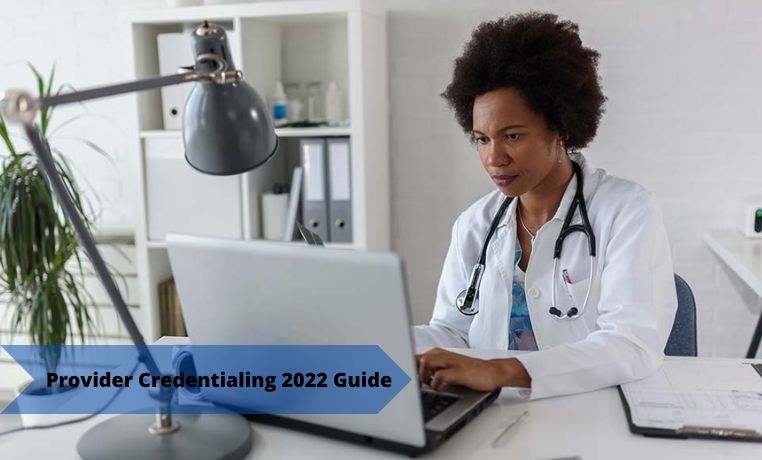Provider Credentialing 2022 Guide

More than ever, we hold healthcare professionals in high regard since some of them put their lives in danger to treat and save our loved ones. Doctors and nurses consistently placed among the occupations with the highest respect levels even before COVID-19. Patients put their faith in a system of checks and balances that enables service providers—physicians and no physicians—to provide services and perform medical procedures safely. Provider credentialing is a rigorous process that healthcare providers must go through in order to operate in or affiliate with a hospital or healthcare system and get payment for their services there.
What is provider credentialing?
Although we tend to conceive of the provider-patient interaction as being a one-to-one. Several administrative roles at hospitals share the burden of making sure the clinician provides safe, high-quality care. One aspect of this responsibility—verifying providers’ past and present competency levels to make sure they are fit for their roles—is the subject of provider credentialing.
The provider credentialing procedure is a requirement before an organization can award clinicians clinical privileges to carry out patient history and physical examinations, open heart surgery, or write prescriptions for medications in a hospital setting. BellMedEx Provides Medical Credentialing Services for all kind of practices.
Hospitals and healthcare facilities employ a multi-step procedure called provider credentialing to collect and confirm information on practitioners’ licenses to practice medicine. It Carrie out on practitioners who are link with the organization as well as those who are employed by it. Such as a community doctor who applies to join the hospital’s organized medical staff. In doctors’ private practices, credentials are rarely checked. Download this eBook that details the entire procedure for additional information.
How does provider credentialing work?
A provider organization’s or payer’s credentialing department, as well as an internal or external CVO, completes the provider credentialing process in stages. Credentialing personnel:
- Obtain data from a variety of sources, including the provider—a step that frequently requires intensive follow-up work.
- Make suggestions for credentialing, whether for consideration of clinical privileges or enrollment with a payer or payers.
- Primary source verification (PSV) of the gathered information and documentation.
Obtaining all required paperwork and certificates is part of the process of gathering provider information. After completing this stage, the data is verify for legitimacy and accuracy. Although it ultimately depends on whose regulatory and/or accreditation body the organization adheres to, the specific data and papers that are collected are pretty uniform. The National Committee for Quality Assurance, The Joint Commission, The National Association for Healthcare Quality, DNV-GL, Individual State Oversight Bodies, The Centers for Medicare & Medicaid Services, Utilization Review Accreditation Commission, and many others are examples.
Primary source verification
Because secondary sources of information could contain inaccurate, untrustworthy, or biased information. It is imperative to consult the original source, or issuer, of the data or document. Think about how simple today’s technology allows healthcare professionals or fraudsters to falsify or exaggerate credentials in order to acquire patient access. PSV is therefore a crucial step in the credentialing process. If done incorrectly. The outcomes could include patient damage or death as well as negligent credentialing lawsuits costing millions of dollars.
The typical PSV steps can be:
- Verify the main source verification criteria for your state.
- Verify the information requested by NCQA, TJC, or URAC, such as training and education, licenses, and malpractice histories.
- Verify the provider’s prior employment.
- Verify the existence of and history of claims for professional responsibility.
- Verify the provider’s status for board certification (if applicable).
- Verify the provider’s training, residency, fellowship, and original source education.
- Verify the provider’s notarized government-issued identification as well as their OIG and criminal history records.
Once all information have been acquire, the credentialing professional or function evaluates the full provider data file collectively to confirm accuracy. The objective is to ensure, to the greatest extent feasible, that all data accurately portrays a provider. In other words, are they qualified to work in the healthcare company on a clinical, personal, and professional level? The credentialing process examines a person’s history, experience, and past as well as their license and ability to practice medicine.
Rarely do CVO employees or credentialing specialists themselves make credentialing decisions. Instead, they offer the information and crucial insight that managers and committee members need to advance the provider through the process.
Provider credentialing refused or delayed if one of these procedures is not follow correctly. An error made at any point during the process could result in financial loss for the applicant or the organization, the need to restart the hiring process, or even the denial of the desired position. Errors or poor provider credentialing also hold down the provider organization’s capacity to charge for provider services. Which negatively impacts cash flow in the revenue cycle. Making sure all information is verify and keeping a watchful look out for gaps in the applicant’s background are two easy ways to avoid issuing credentials to unqualified applicants.
Has provider certification evolved?
Although significant regulatory and certification requirements for credentialing are uncommon, technology, integration, and expectations for excellent patient engagement and provider service are fundamentally altering the procedure in the following ways:
Enrollment of payers and credentialing are integrating
Only lately has enrollment in hospitals become a function requiring administrative staff and resources on par with medical care. This was brought on by a number of circumstances, such as the move toward employing healthcare professionals, hospital and health system closures, mergers, and consolidations, as well as the need to recover every dollar possible under value-based care models. Healthcare executives recognize a synergy between enrollment and credentialing as well as an opportunity for efficiency as its significance develops.
There will be no paper credentials anymore
Paper transactions are not safe, while digital exchanges make it simpler to convey knowledge. The transition to digital provider data management systems is also drive by storage/space issues and environmental concerns.
For more users, the source of truth is data that has been verified
More and more authorized departments and individuals are accessing and using the provider data that medical credentialing specialists manage. The procedures of credentialing, privileging, quality/safety, and enrollment generate millions of data points that are used in healthcare governance, risk management, and compliance (GRC).
The final word on provider credentials
Hundreds or thousands of data points must be collected, reviewed, and assessed for character as part of the provider credentialing process, and mistakes can be expensive for the provider, the organization, and ultimately the patients. Beginning with the end in mind, every healthcare institution works to provide patients with the best, safest treatment while safeguarding all participants. The duty for achieving this aim is shared by many organizational departments. With that in mind, it is possible to completely comprehend what provider credentialing is and why it is crucial. Following best practices for credentialing consistently ensures that our healthcare staff members are thoroughly educated and prepared to deliver the high-quality care that our healthcare community values.




